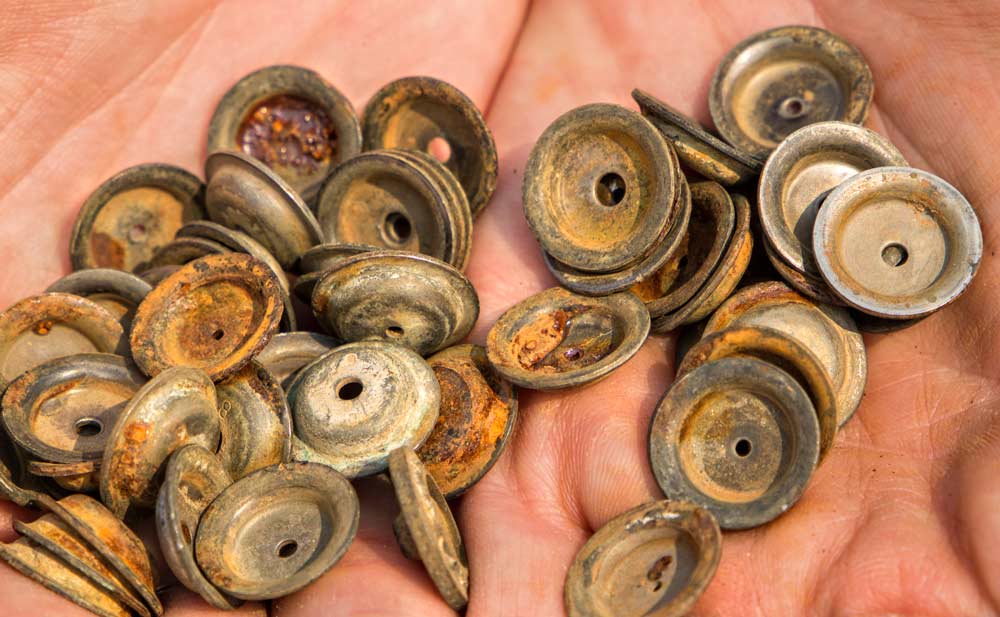
Margaret McCoy, a Washington State University graduate student studying spray technologies, shows a collection of used, rusted disc-core nozzles, the kind often found in a growers’ shop. (Shannon Dininny/Good Fruit Grower)
When’s the last time you changed your spray nozzles?
If the answer is, “Hmmm, I’m not sure,” or “Maybe three years ago,” well, that’s the wrong answer.
Nozzles are often overlooked during routine sprayer maintenance, yet they are a significant factor in whether your pest and disease management regimes are effective. Nozzles control the flow rate (gallons per minute) and coverage of product you’re delivering. And, whether they are working appropriately — or at all — nozzles can mean the difference between a hassle-free vineyard and a season-long headache.
With newer nozzles, growers also may find it harder to differentiate between those that are well used and those that aren’t, so it’s good practice to, at a minimum, evaluate nozzles each year — or better yet, just plan on swapping them out annually.
“I always think that farmers treat their sprayers like they treat their cars: Put gas in it and expect it to run,” said Margaret McCoy, a WSU graduate student researching spray technologies. “Oil change, rotate your tires, calibrate and change your nozzles. It’s worth the 15 minutes and $5 to change out your nozzles.”
Choosing the correct nozzle for specific tasks can be daunting. There are numerous varieties on the market, made of different materials, and they can produce different spray droplet sizes and patterns.
That means not all nozzles are appropriate for every task, McCoy said; rather, nozzle selection is situational, depending where you want to use them and for what purpose.
As part of WSU’s viticulture and enology field day in August, McCoy offered tips for growers on nozzle maintenance and selection. Here’s a recap of some standard nozzle types for vineyards, which produce a spray in a hollow-cone pattern for sprayers with interchangeable nozzle tips, and the pros and cons for each.
Disc-core
Disc-core nozzles feature two interlocking pieces, a disc that looks like a tiny Frisbee and a core that is flat on one side with a mountain in the center of the other. Droplet size is generally 100 to 340 microns (a micron is 1/25,000 of an inch). They are widely used across most situations.
—Disc-core, stainless steel: These are the industry standard. They are more durable than brass, but they come with a few downsides: It’s fairly easy to place them in the wrong position, and droplet sizes can vary widely. (You also may need reading glasses for the small identification print on the nozzle.) The cost is about $5 per nozzle.
—Disc-core, ceramic: The ceramic version of these nozzles is far more durable than stainless steel and holds up better to corrosive products, such as sulfur and oils, but the droplet sizes can still vary widely. In addition, the ceramic can crack or chip if a nozzle is over-tightened. Cost: about $6.50 per nozzle.
One-piece
Then there are the nozzles that come in one piece and stick out from the nozzle body. Each of these is color-coded for easy identification, with each color representing spray for a specific flow rate at a specific psi.
—One-piece, ceramic: These nozzles are appropriate in most vineyard and orchard settings and, since they are ceramic, hold up better to corrosive products, such as sulfur and oils. They produce a finer droplet size (60 to 235 microns) when compared to the standard disc-core option, which can lead to good coverage on a surface, but the smaller droplets can drift easily. Most growers are aware of this and adjust their practices accordingly, McCoy said. The cost is about $4.65 per nozzle.
—Air-induction, ceramic: Air induction nozzles have a different spray pattern than fine droplets, because they introduce air into the water stream, filling the droplet with tiny air bubbles. Once the droplet hits a leaf or fruit, it shatters onto the surface. These larger droplets weigh the same but are larger and have more drag, so they tend to drift less, but they may not provide the fine-tuned level of coverage you’re seeking. They generally cost about $10.65 per nozzle; the price drops for bulk purchases (for 100 or more) to about $8.35 each.
The nozzles are great for certain situations, she said. “People often use these in weed sprayers because it’s important to not drift in that situation,” she said. One attendee likened the nozzle to a tiny hand grenade, and McCoy laughed. She plans to use that description next time around. “If you’re going to use the AI nozzles, you should test them and look at your coverage pattern using water sensitive paper.”
Generally, there is no “one-size-fits-all” option for nozzles; each has limitations and some are more appropriate to use in certain situations than others, McCoy said.

The water-sensitive paper on the left shows the resulting spray from a standard, one-piece nozzle, with a flow rate of 0.47 gallons per minute. On the right, the spray from an air-induction nozzle at 0.46 gallons per minute. The volume of spray is close to the same, McCoy said, but the coverage is vastly different — like comparing a mist to rain. (Shannon Dininny/Good Fruit Grower)
However, WSU recommends, regardless of nozzle type, that growers maintain and calibrate their sprayers and check their nozzles annually. •
ONLINE
For a simple, six-step process to optimize and calibrate your sprayer with interchangeable nozzles, visit WSU’s spring 2016 issue of the Viticulture and Enology Extension Newsletter at bit.ly/2xt8Hc9
– by Shannon Dininny






Leave A Comment